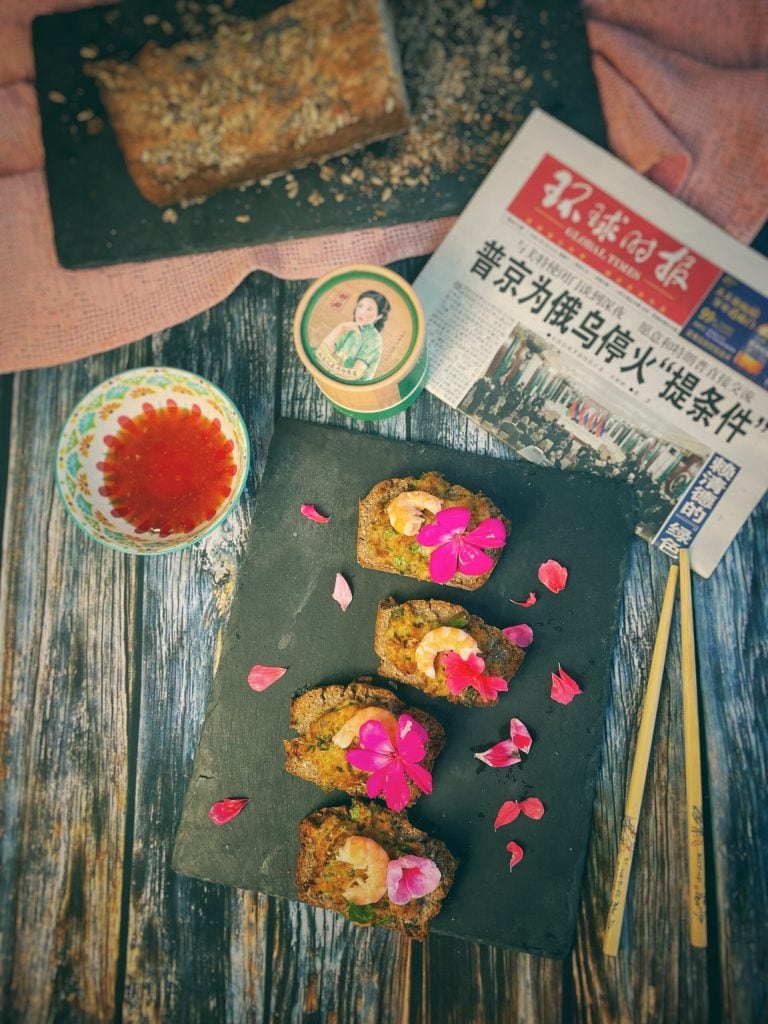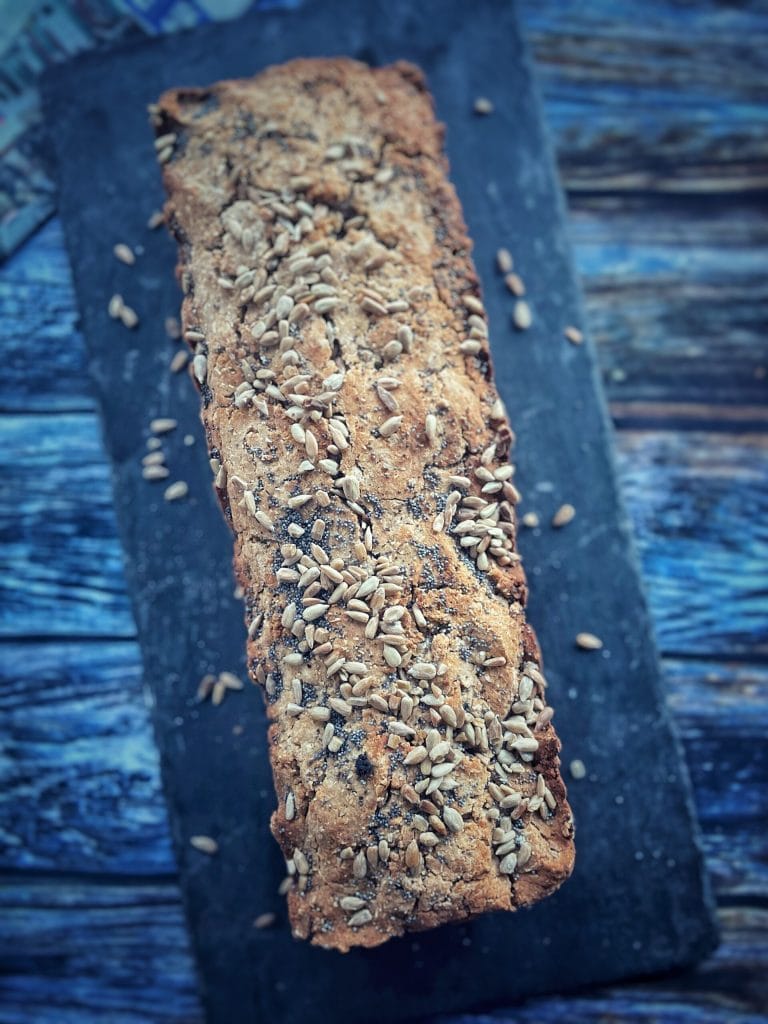The Haa Dō Si (蝦多士) is the famous Chinese shrimp toast, originating from Cantonese cuisine and often served in dim sum or as an appetizer.
蝦 (haa) = shrimp
多士 (dō si) = Cantonese transliteration for “toast” (from the English term “toast”).
This specialty originates in Hong Kong and is considered part of the most authentic Cantonese cuisine.
The dish consists of:
– a cream of fresh shrimp (not cooked) enriched with aromatic ingredients (ginger, scallion, soy sauce, sometimes a touch of sesame oil).
– Crustless white bread, on which the shrimp mixture is spread.
The frying is the traditional method: first on the shrimp side, then on the other, to make it crispy but with a soft and flavorful interior.
A common variant in the UK, Australia, and Ireland is sesame shrimp toast, where sesame seeds are sprinkled before baking or frying.
This version does not use sesame seeds, staying true to the original Hong Kong preparation, enriched with rose geranium and, for a gluten-free version, I have also prepared toast bread made with buckwheat flour.

- Difficulty: Easy
- Cost: Economical
- Preparation time: 10 Minutes
- Portions: 8Pieces
- Cooking methods: Frying
- Cuisine: Chinese
- Seasonality: All Seasons
Ingredients
- 7 oz shrimp
- 1 egg white
- 1 tsp cornstarch
- 1/2 tsp sesame oil
- to taste ginger
- 1 scallion
- 4 slices white sandwich bread (crustless)
- to taste rose geranium
Steps
Prepare the shrimp paste: finely chop the shrimp (save a few shrimp for decoration) with a knife or use a mixer to obtain a homogeneous paste.
Transfer it to a bowl and add the egg white, cornstarch, soy sauce, sesame oil, ginger, and scallion.
Mix well until you get a uniform mixture.
Prepare the toasts: cut the bread slices into rectangles.
Spread a generous layer of shrimp paste on one side of each triangle. Press lightly to adhere the mixture well.
Fry the toasts: heat abundant oil in a pan over medium-high heat.When the oil is hot, fry the toasts with the shrimp side down for about 2 minutes, until they become golden.
Flip the toasts and fry the other side for another minute. Drain on paper towels.
Garnish with rose geranium flowers.
Serve the shrimp toasts hot, accompanied by a sweet and sour sauce or a spicy chili sauce.

Rose Geranium:
The rose geranium (Pelargonium graveolens) is also cultivated in China, where it has gained a significant role in the essential oils industry.
🌿 Cultivation of rose geranium in China
China is currently one of the world’s top producers of rose geranium essential oil, along with countries like Egypt, Morocco, and Réunion.
The cultivation is particularly widespread in the Yunnan province, a region characterized by a subtropical climate and altitudes below 5,249 feet, ideal conditions for the growth of this aromatic plant. The warm and sunny climate encourages the accumulation of essential oil in the leaves, increasing the yield and quality of the final product.
🧪 Production and use
The rose geranium essential oil produced in China is widely used in the cosmetic and perfumery industry, thanks to its floral scent similar to that of roses. It is also used in aromatherapy and skin care products.
The quality of Chinese oil is recognized internationally, making it an important export item for the country.
🌍 Global relevance
Besides China, rose geranium is cultivated in various other regions of the world, including India, Crimea, Georgia, and South Africa.
However, Chinese production stands out for its scale and the efficiency of the agricultural techniques employed, contributing to meeting the growing global demand for rose geranium essential oil.
However, Chinese production stands out for its scale and the efficiency of the agricultural techniques employed, contributing to meeting the growing global demand for rose geranium essential oil.
Geraniums are indeed edible flowers and can be used for both decorating dishes and in recipes, such as making omelets, risottos, or liqueurs.
Just like lavender, whose incense I wanted to pair with the dish.

FAQ (Questions and Answers)
What is the difference between the traditional shrimp toast and the dim sum version?
The main difference between the 蝦多士 (Haa Dō Si, the traditional shrimp toast) and the dim sum version is mainly in presentation and texture.
Shape: in the traditional version the bread is whole or halved, often cut into a large triangle or rectangle. In the Dim Sum version, the portions are much smaller, often cut into small squares or tiny triangles.
Filling: thick layer of shrimp paste (abundant) vs thinner layer of shrimp paste.
Frying: more rustic: crispy outside, very soft inside vs more delicate and lighter frying, often less oily.
Additions: pure shrimp filling; no or very few extra seasonings vs sometimes small amounts of bamboo, finely chopped ginger, or even a touch of fish paste are added.
External appearance: simple vs more often decorated with sesame seeds or lightly brushed with egg for a glossy appearance.
Context: more homemade snack or from cha chaan teng (Hong Kong cafes) vs served in dim sum restaurants on carts or elegant plates.Is Chinese shrimp toast also served in Japan?
The dish was introduced to Japan during the Meiji period through the port of Nagasaki, whose local Shippoku cuisine fused Chinese, Japanese, and Western cooking.
In Japanese, shrimp toast is known as hatoshi (ハトシ), a loan from Cantonese.
Many Chinese restaurants and shops in Nagasaki’s Chinatown still serve this dish.
Some also serve a pork-based variant.Can shrimp toast be “fried” in an air fryer?
Of course, for a lighter version, you can bake the toasts in a preheated oven at 392°F for about 10-12 minutes, or in an air fryer at 356°F for 8-10 minutes, until they are golden and crispy.
You can purchase the Cosori air fryer on the COSORI website with a 25% discount for all of May (starting June, 15%), with the discount code: VIAGGIANDOCOSORI15What is the recipe for gluten-free toast bread with buckwheat flour?
For a 12 x 4.7-inch pan: add to 21 oz of buckwheat flour, 2.8 oz of coconut flour, 1.7 cups of water, 7 oz of gluten-free sourdough (or 0.8 oz of fresh yeast), 0.6 oz of sugar, 2.1 oz of butter, 0.6 oz of salt.
Let rise covered for 45 minutes.
Place the dough in the mold and let rise for another hour.
Bake in the oven at 374°F for 35 minutes.
Decorate with seeds.
And the recipe for classic sandwich bread?
You can find the recipe for classic sandwich bread on the Sara’s blog Sarabuonodavvero with whom I collaborated through Instagram to create a different version of Shrimp Toast. The one in the photo is hers.


